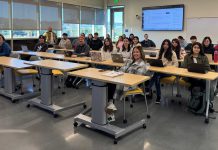GILROY
– The unique vision and management abilities of the chief of
Gilroy schools will be featured in a documentary to air on the
Discovery Times Channel tonight.
By Lori Stuenkel
GILROY – The unique vision and management abilities of the chief of Gilroy schools will be featured in a documentary to air on the Discovery Times Channel tonight.
Superintendent Edwin Diaz is one of four education insiders who are the focus of the hour-long “Learning the Hard Way,” a documentary capturing the condition of the state’s public education system as California faces its biggest budget deficit since the Great Depression.
A film crew followed Diaz during the course of a few weeks this summer to show both his successes during three years as superintendent and his daily challenges in managing a complex school district. The crew toured Gilroy with Diaz and attended one of his Parent Advisory Committee meetings.
“(The documentary filmmakers) asked a lot of hard questions about the difficulties of making changes and meeting everyone’s needs when resources are scarce,” Diaz said. “It was a real comprehensive look.”
David Winton, of Winton duPont films and executive producer and director of the documentary, praised Diaz for bringing a fresh perspective to the film. Diaz has a difficult job and few easy decisions to make, Winton said, but has proven to be a capable leader.
“We didn’t set out looking for a great leader – we happened on one,” Winton said. “He set very aggressive targets and is willing to be held accountable for them. I think that made his story particularly interesting and quite dramatic.”
Makers of “Learning the Hard Way” wanted to show viewers a portrait of California’s public education system from the perspective of people inside it, as opposed to having outside experts analyze it. Diaz, and Gilroy as a whole, offered a glimpse into a school system that incorporates a wide range of income levels and different ethnic groups, Winton said.
“We wanted (Diaz) to describe the unique conditions confronting educators in communities like Gilroy, which are a mix of both recently immigrated families and families who have been in the community for a while,” Winton said.
Diaz and Gilroy Unified were chosen based on the recommendation of Rudy Crew, former chancellor of New York public schools and current director of district reform initiatives for the Stupski Family Foundation. The foundation, founded in 1996, is a private philanthropic foundation that supports public education improvement and has granted GUSD more than $1.7 million to fulfill that goal.
“(Crew) recommended that we show a school district that was representative of the mix of rural and suburban communities and education issues that are unique to them,” Winton said.
The filming and interviewing process made it clear to Diaz that Gilroy Unified reflects the state educational system’s challenges because there are large percentages of both English language learners in Gilroy and people with access to higher education, he said.
“I was able to really come to grips with the fact that what we’re dealing with in Gilroy is really representative of the difficulties we’re facing in California,” Diaz said, “trying to have all kids achieve at high levels while meeting all diverse needs in an environment that is challenging.”
“Learning the Hard Way” follows three other people who paint a picture of the state of California’s public schools as the state faces a $40 billion deficit next fiscal year. This state’s public education system, singular in its size and diversity, could foreshadow what the rest of the country could face as budgets are tightened, Winton said.
Educators in California are, above all, doing more with fewer funds, Winton said.
“We felt that it would be better if we, with a minimum of comment, showed what public education is like today versus five years ago, when funding levels were quite high,” Winton said. “It’s just an attempt to make an interesting story of the experiences of people who were in the middle of the system.”
Monique, a black eighth-grade student at Nobel Middle School in the San Fernando Valley, describes the difficulties of attending a school outside her neighborhood. Richard Martinez is a Hispanic science teacher in the Los Angeles Unified School District who attended Yale on an athletic scholarship and returned to his alma mater four years ago. He now teaches between 130 and 150 students each semester who, like himself, come from low-income homes. Also featured is Suzanne Blake, an assistant principal in an East Bay school district who mentors at-risk youth.
“They were all similar in that they were all very bright, extremely motivated and hard-working people who have learned to make the best they can with the resources they have,” Winton said. “I think the viewer has a more intensified view of what pubic education looks like from the inside looking out.”
A secondary purpose of the documentary examines the impact of the current political storm on public education and the players within it.
The state of the economy and education funding are important factors in the upcoming gubernatorial recall election, Winton said.
The documentary crew focused on the tail end of the 2002-03 school year, starting their filming in May and continuing through mid-summer with the start of summer school. Portions of the segment focusing on Gilroy were filmed at Glen View Elementary School and Brownell Academy Middle School. Because Diaz, Blake and other administrators work year-round much of their segments was filmed during the summer months, Winton said.
“Learning the Hard Way” airs from 8 to 9 p.m. today on Charter cable channel 203, the Discovery Times Channel.













